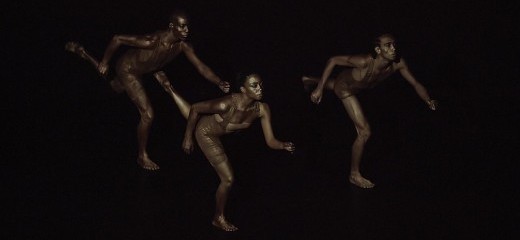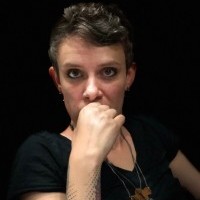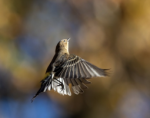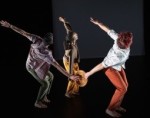
The Magical Realism in TRIBE’s Black Hole
by Emilee Lord
There’s a shifting amorphous form far downstage as the audience settles in. A projection of spots, moving as seaweed underwater, undulates over the surface of something that you cannot see or name. I heard other viewers wonder aloud with me if there were bodies there, waiting to emerge. We were not wrong.
The premiere of Black Hole: Trilogy and Triathlon by Shamel Pitts and the Brooklyn-based collective TRIBE began with bodies emerging from under a black tarp designed by Naomi Maaravi. They crawled on their hands, pelvis down, chins up, away from us. The slow articulations of the shoulders, hands, and spine, as hips pivoted for knees to pull forward, set a tone that would be punctuated, shaken up, and played with but not altered too far off course. Pitts emerged first. Performers Marcella Lewis and Tushrik Fredericks followed. From this moment on, they remained together, exploring a landscape or sound field.
The piece's atmosphere was otherworldly, the aesthetic that of Afrofuturism. Three figures navigated a non-space with undulating clarity, weight-bearing, reaching, ticks of energy, and movements in unison; not typical dance unison, but moving as a singular organism, one where all parts aligned for strength and direction as the dancers entwined themselves and slid or walked as a unit. This aspect of the movement began to feel like one of the themes of the work--unification and advancement from a place of all time and all being.
The moving bodies were arranged in diagonals and lines or triads, exchanging who was at the head. The music composed by Sivan Jacobvitz and the sound design by Zen Jefferson was accumulative and commanding. Each new layering only nudged the other layers out of the way a bit, but they were still audible. The sound grew in intensity in this way, and when it cut out, it halted everything. At one point the soundscape shifted into a loud beat that pulled them out of the slow wave-like choreography into pulses and repeats of closing and extending, always on the count. It was so startling a change in pace that I felt I could see after marks of it in the space when it ebbed away.
The video and light projections designed by Lucca Del Carlo added to the otherworldly nature of the environment in which the dancers moved. At least one dancer often looked toward the light source throughout the piece. There were moments when the focus would shift to acknowledging each other, and those moments were embedded with care and gentleness. A questioning look moved them toward each other to put hands on hearts or heads. They held and supported one another, taking time to repair each other along the journey. Outside of these, there was always this light, this external entity drawing their attention. With the dancers’ virtually expressionless faces throughout the piece, it was hard to say what this source was offering them, impeding them from, or challenging them to do. But it was clear though that there was a source, perhaps of power, or purpose, or sometimes of suffering or tension.
In the section of solos, Pitts moved with a red projection and lifted himself from the floor into extensions and slow contortions of the torso. He ended by placing a hand over his ear. Frederick, projected in blue light, finished with a hand over one eye. Lewis, in a green light, came downstage to cover her mouth. They were pulled asunder by something, asked to act alone, and then came together with hand gestures for the age-old theme of not hearing, seeing, nor speaking evil. And I wondered, what evil, who’s evil?
Adding to the story, non-linear and spatial as it was, were the differentiated physicality of the dancers. Pitts held a wide-eyed strength and calm about him. Fredericks had moments of quiet aloneness marked by bursts of energy and agonizing bends. And Lewis felt her way through the space, sometimes seeming to hold air, often describing a round wholeness in front of her. Each of the dancers made quick finger gestures.
There appeared to be multiple endings via a build-up that exploded into various end stages. So, I felt triumphant for one moment, but it was not done. Then I was entwined with them again, watching support and care, and still not done. Then I saw them face a powerful force, but it was not the end. And finally, they slowly disappeared into the dark. While my initial response was confusion around a clear ending, I think this layering of climactic energy was to the point. These endings were all possible.
Black Hole is a work of magical realism. Where was this land? Where did they come from? What path were they on? Was this source an entity of goodness or harm? This piece was riddled with questions, but the good kind you feel being answered viscerally in front of you while allowing yourself not to know but be moved. Upon leaving, I heard another audience member say, "well, that changed my life. I'm on a whole new trajectory now," and I have no misgivings as to why she said that.
Black Hole: Trilogy and Triathlon, New York Live Arts, April 21-23
Image Descriptions
1. Three figures sit in a line in a dark space. They are sitting partway between each other's legs, with knees drawn up, feet flat on the floor, fingers tips on the floor behind them, and looking up.
2. Three figures in a running posture, right feet on the ground left feet up and behind them, left fists forward, and right fists drawing back.
By Emilee Lord
April 28, 2022










